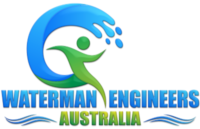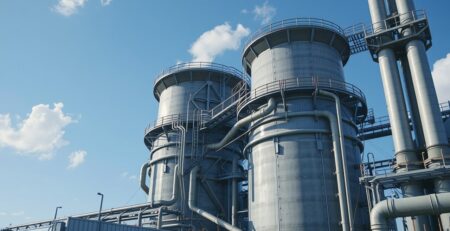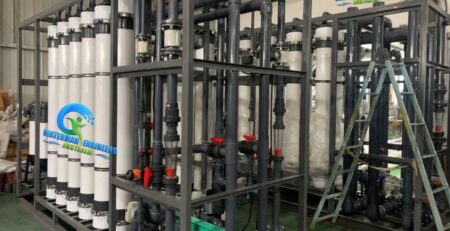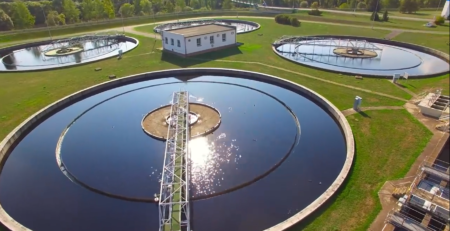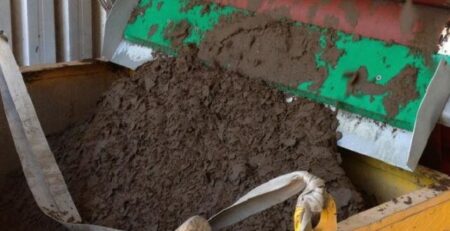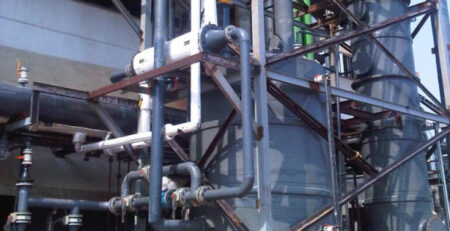Chemical Precipitation or Sedimentation Tanks to Reduce The Hardness of Industrial Wastewater
Sedimentation is a physical treatment of wastewater method that removes suspended materials from wastewater using gravity. In still water of bodies of water, solid particles trapped by turbulence of flowing water can be spontaneously removed via sedimentation. Settled basins are ponds that are designed to remove trapped materials through sedimentation. Clarifiers are tanks with technical mechanisms for removing sediments deposited by sedimentation regularly. Dissolved effluents are not cleansed by clarification. The act of accumulating sediment is known as sedimentation.
Principle of Sedimentation Tank
The size, specific gravity, and zeta potential of suspended particles affect their clearance by sedimentation. If the specific gravity of suspended solids kept on a screen is equivalent to that of water, they will be suspended, whereas highly dense particles flowing through the filter will settle. The apparent volume gathered at the bottom like an Imhoff cone once the water has subsided for one hour is used to calculate settleable solids. The Navier–Stokes equations as well as the second law of Newton are used to descend the gravitational philosophy. The link between settling rate and particle diameter is explained by Stokes’ law. The rate of particle settling is directly related to the square of particles size as well as inversely proportional to fluid viscosity under certain conditions.
Design
Though sedimentation can occur in tanks of different forms, the quickest way to remove deposited sediments is to use conveyor belts inside rectangular tanks or scrapers spinning around the centre axis in circular tanks. This settling velocity (vs) of the tiniest particle to be hypothetically 100 percent eliminated should be used to build settling basins and clarifiers. For calculating overflow, the equation is as follows:
 There are overflow rate standards for each design that should take into account the variation in particle diameter as the solids pass through the process:
There are overflow rate standards for each design that should take into account the variation in particle diameter as the solids pass through the process:- 0 mm (0.013 ft) per second in full-flow basins
- Zones of quiescence have 9.4 mm (0.031 ft) per second
- 46 mm (0.0015 feet) per second in off-line basins
Flow surges, scour, wind shear, and turbulence, on the other hand, diminish the effectiveness of settling. Long rectangles can be used to build settling basins as well as clarifiers that are more hydraulically secure and easier to regulate for high quantities. Circular clarifiers could be used as condensing without rakes or as up flow tanks.
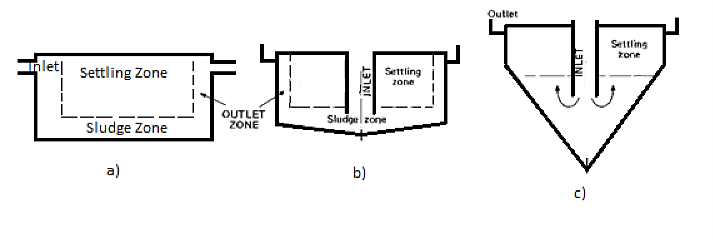 Sedimentation Zone
Sedimentation Zone
There are four zones in the sedimentation tank:
- The Inlet Zone
- The Settling Zone
- The Sludge Zone
- The Outlet Zone
Each zone should flow smoothly from prior ones to the one following it. In addition, each section has a particular purpose. In rectangular sedimentation basins, zones are most visible.
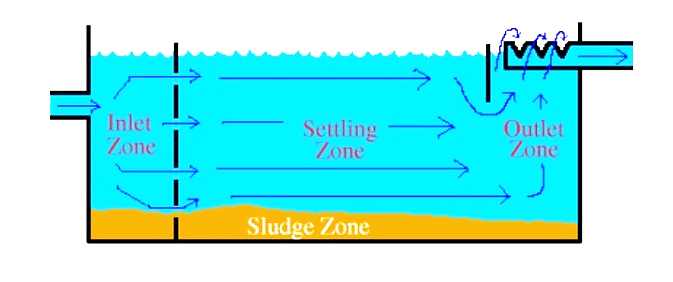 1. Inlet Zone
1. Inlet Zone
The intake zone of a sedimentation basin serves two basic functions: it distributes the water and controls its velocity as it reaches the basin. Inlet devices can prevent turbulence in the water. To avoid short-circuiting, the entering water in a sedimentation basin should be equally spread across the basin’s breadth. Short-circuiting is indeed an issue that exists when water bypasses the basin’s usual flow path and reaches the outflow faster than conventional detention time. Inlets regulate the quickness of the rolling fluid in addition to evading short-circuiting. Because of agitation, when the water velocity exceeds 0.5 feet per second, the floc in the liquid will terminate things. The sedimentation basin’s floc will be broken apart, making settling significantly less effective. Below are two different types of inlets. The porous baffle wall, also called the stilling wall, encompasses the entire basin from top to bottom and sideways. Water flows from the entrance into the sedimentation basin’s settling zone through holes equally placed throughout the stilling wall. Water enters the basin through holes uniformly distributed all across the bottom of the channel and thereafter flows beneath the baffle at the front of the channel in the second type of intake. The channel and baffle work together to uniformly disperse the feed water.
 2. Settling Zone
2. Settling Zone
The water reaches the settling zone after flowing through the intake zone, where its velocity is substantially slowed. That’s where most of the floc settling takes place, and it will account for most of the sedimentation basin’s volume. The settling zone needs a calm, steady flow of water for best performance. A huge expanse of open waterbody could serve as the settling zone. Tube settlers, as well as lamella plates, are sometimes included with the settling zone. In sedimentation basins, tube settlers, as well as lamella plates, improve settling efficiency and speed. Each tube or plate acts as a mini-sedimentation basin, doubling the settling surface.
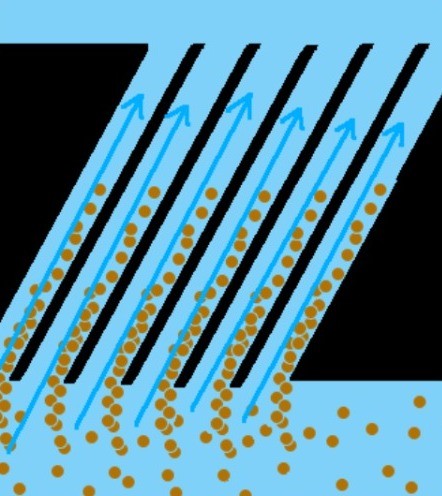 3. Outlet Zone
3. Outlet Zone
The fluid flow out from the sedimentation basin is controlled by the outlet zone, which regulates both quantity of water exiting the basin and the area wherein the outflowing water is pulled. The exit zone, like the entrance zone, is created to stop water from short-circuiting in the basin. A good outflow will also ensure that only well-established water exits the basin and reaches the filter. The outflow can also be utilized to regulate the basin’s water level. Outlets are designed to keep the quantity of floc suspended in the water moving out from the sedimentation basin to a minimum. As the greatest quality water is commonly encountered at the peak of the sedimentation basin, outlets are usually constructed to sweep this water out. A baffle at the front of the wastewater is typical of an outflow zone. Floating material cannot escape the sedimentation basin as well as clog the filters because of this barrier. The effluent structure follows the baffle and often includes a launder, effluent pipes, and weirs.
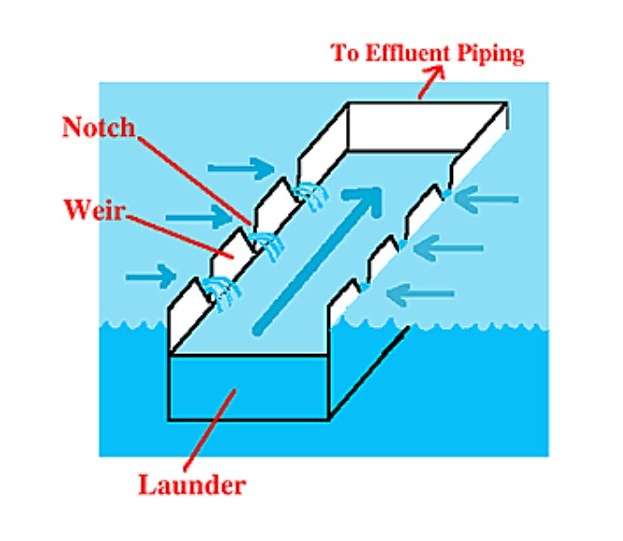 The discharge launder, a trough that gathers water pouring out from the sedimentation basin as well as distributes it to the effluent pipes, is the most important part of the effluent structure. Weirs are usually attached to the sidewalls of a laundry. Weirs are barriers that prevent water from pouring uncontrollably into the washing machine. The weirs are used to evenly skim the water off the tank.
The discharge launder, a trough that gathers water pouring out from the sedimentation basin as well as distributes it to the effluent pipes, is the most important part of the effluent structure. Weirs are usually attached to the sidewalls of a laundry. Weirs are barriers that prevent water from pouring uncontrollably into the washing machine. The weirs are used to evenly skim the water off the tank.
Along the length of a weir, there are frequently notches, holes, or slits. Water will flow into the weir through these apertures. The V-shaped notch seen in the image above is the most frequent style of the hole, allowing only the topmost inch or so of water to run out from the sedimentation basin.
4. Sludge Zone
The sludge zone is a section of the sedimentation basin’s bottom where sludge settles for a short time. To avoid sludge re-suspension, the speed in this zone must be very moderate. The sludge may be readily removed from the chamber thanks to drainage there at bottom of the basin. To make sludge removal even easier, the bottom of the tank must slope toward the drains.
Influencing Factors of Sedimentation Tank
Sedimentation is influenced by several causes, including:
Detention Time
It’s time for detention. For complete sedimentation, a sufficient detention time is required. The less time spent in detention, the less settling, and the higher the turbidity, as well as conversely.
Turbulence on the Surface
The rate of sedimentation decreases when turbulence increases, and vice versa.
Velocity
Higher velocities produce re-suspension of a deposited floc, which can generate significant effluent turbidity by rising to the surface. The particles in the basin would not be appropriately distributed if the velocity was too low.
Temperature
The faster the sedimentation gets as the temperature increase, and vice versa. Water is lighter and settles faster at higher temperatures.
Short Circuits
Because of the short detention time caused by short-circuiting, sedimentation is ineffective.
Inlets and Outlets
There are inlets and outlets. Horizontal flow basin inlets and outlets should be suitably positioned to enable better blending of the water and avoid short circuits.
Dimensions
The basins’ size is also critical, notably their depth, which should be at least 15 feet.
Sludge Withdrawal
Controlling the substantial of the basin, sludge breakdown, and sludge scouring all require efficient sludge withdrawal. When opposed to a lighter fluffy or flaky sludge, denser sludge settles quickly and should be cleaned at a faster rate.
Chemical Feed Points
Chemical feed points should be selected to ensure that each chemical reacts properly with its target component, e.g., alum must always be given before lime.
Applications of Sedimentation Tank
Potable Water Treatment
Sedimentation in drinkable water purification is usually preceded by a stage of chemical coagulation-flocculation, which permits articles to be grouped into larger flocs. This speed up the settling of suspended particles and permits colloids to settle.
Treatment of Wastewater
For millennia, sedimentation has also been used to remediate wastewater. Sewage treatment begins with the sedimentation of buoyant and capable materials. Primary clarifiers decrease suspended solids concentration as well as contaminants embedded in suspended particles. Some secondary treatment techniques, such as trickling filters, activated sludge, and rotating biological contactors, use sedimentation tanks termed “secondary clarifiers” to eliminate flocs of biological growth.
Industrial Wastewater Treatment Frequently Asked Questions
1) What is chemical precipitation in water treatment?
Chemical precipitation is the transformation of compounds dissolved in water into solid particles used in the treatment of water and wastewater. By adding counter-ions to decrease their solubility, chemical precipitation is used to remove ions from water.
2) What are the common chemicals used in the chemical precipitation process for water and wastewater treatments?
Potash alum, sodium bicarbonates, ferrous sulphate, ferric chloride, and lime are typical precipitation chemicals (Aziz et al., 2008). pH and temperature are the two key regulating variables in the precipitation process. Contaminants can be removed to a greater than 60% level.
3) What is the most commonly used chemical precipitating reagent?
The most common type of chemical precipitation is known as hydroxide precipitation, which produces metal hydroxides by employing sodium hydroxide (caustic) or calcium hydroxide (lime) as the precipitant.
4) What are the advantages and disadvantages of chemical precipitation?
Benefits and drawbacks: The ability to produce pure and uniform material is the primary benefit of the precipitation process. However, the two main drawbacks are the need for product separation following precipitation and the production of significant amounts of salt-containing solutions.
5) What are three uses of precipitates?
The precipitate is the solid that results from a precipitation reaction. Important purposes are served by precipitation reactions. They are employed in the purification process, in the removal or recovery of salts, in the production of pigments, and in the qualitative examination of substances.
6) Why should we use the sedimentation process in wastewater treatment?
By eliminating particles, sedimentation improves the filtration procedure. The process of sedimentation involves removing suspended particles from water via gravity or separation.
